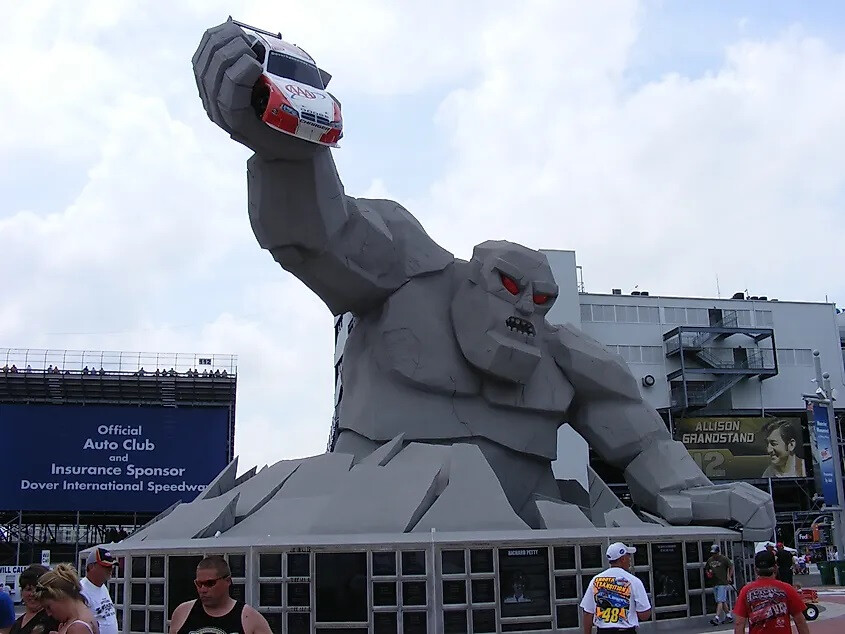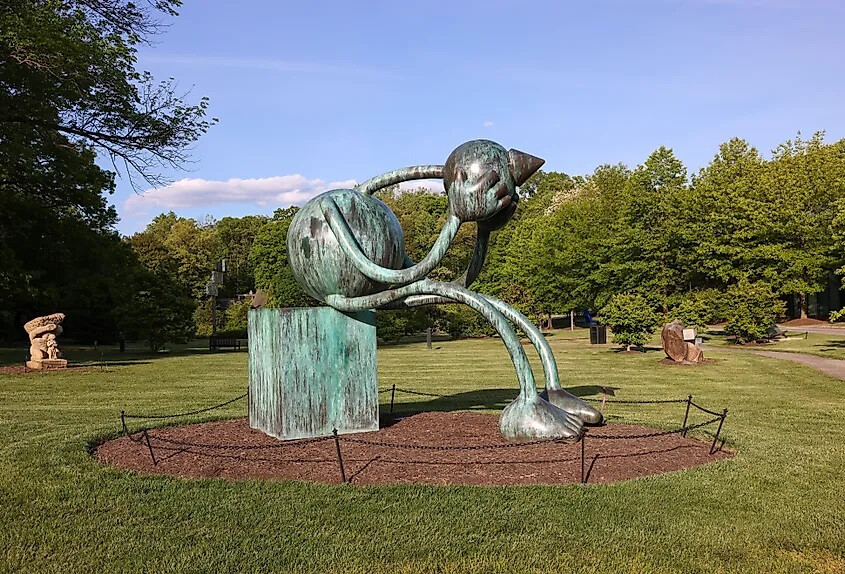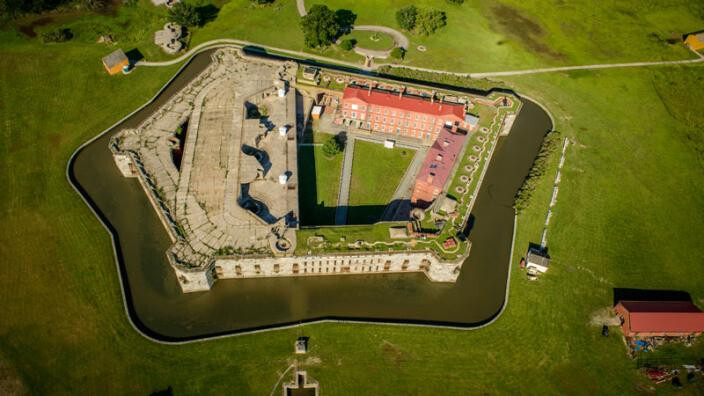
Delaware, though geographically small, boasts a rich tapestry of history, culture, and unique attractions. While its historical significance as the "First State" is well-known, it also harbors a collection of landmarks that might strike visitors as particularly unusual. World Atlas has identified ten of these intriguing sites, each offering a glimpse into Delaware's distinctive character.
1. Old Swedes Church: A Testament to Time
Nestled in Wilmington, Old Swedes Church, formally known as Holy Trinity Church, stands as a venerable sentinel of the past. Its origins trace back to the New Sweden Colony, established in the Delaware Valley in 1638. To safeguard their settlement, the colonists erected Fort Christina, named in honor of Queen Christina of Sweden. Three decades later, in 1697, Reverend Erik Björk arrived from Sweden and galvanized the community to construct a more permanent place of worship. The completed church was consecrated on June 4, 1699.
This edifice is constructed from locally sourced granite and Swedish bricks, a testament to the settlers' resourcefulness and heritage. It occupies the former burial grounds of Fort Christina, a poignant juxtaposition of defense and faith. Old Swedes Church holds the distinction of being the oldest religious building in the United States still in continuous use as a church. Today, it is part of the Episcopal Diocese of Delaware and Trinity Parish and continues to serve as an active place of worship.
Recognized as a National Historic Landmark, Old Swedes Church is also an integral component of the First State National Historical Park, a network of six significant sites scattered throughout Delaware. The church offers tours during the spring and fall seasons, providing visitors with insights into its history and architecture. Educational and public programs further enrich the experience. A notable annual event is the Sankta Lucia celebration in December, organized by the Delaware Swedish Colonial Society, which honors St. Lucia, the bringer of light, a tradition deeply rooted in Swedish culture.
2. Fort Delaware: Echoes of the Past
Perched on Pea Patch Island in the Delaware River, Fort Delaware is a formidable reminder of the nation's military history. Constructed in the mid-19th century, its primary purpose was to protect the strategic ports of Wilmington and Philadelphia from naval incursions. The fort's imposing presence and strategic location made it a crucial defensive asset.
During the Civil War, Fort Delaware assumed a somber role as a prison for Confederate prisoners of war. Thousands were incarcerated within its walls, and tragically, many succumbed to disease and harsh conditions. This period of the fort's history has contributed to its reputation as a site of considerable historical and emotional weight.
Designated as a National Register of Historic Places site, Fort Delaware has also garnered attention for its purported paranormal activity, earning it a reputation as one of the most haunted locations in the United States. The fort was even featured on A&E's "Ghost Hunters," further fueling its mystique. Today, Delaware State Parks manages the site, offering both historical tours and, for the intrepid, paranormal explorations. Living history interpreters bring the fort's past to life, providing visitors with immersive experiences.
Beyond its historical significance, Pea Patch Island offers natural attractions. The Prison Camp Trail allows visitors to explore the island's landscape, while the Pea Patch Heronry is one of the largest mixed-species nesting colonies for herons, ibis, and egrets in the region, providing a haven for birdwatchers. Access to Fort Delaware is via a half-mile ferry ride from Delaware City, adding to the sense of isolation and historical immersion.

3. Ashland Covered Bridge: A Rustic Relic
In the verdant landscape of Hockessin, the Ashland Covered Bridge, also known as the Barley Mill Road Covered Bridge, stands as a charming relic of a bygone era. Constructed in 1860, it holds the distinction of being the oldest and smallest original covered bridge in Delaware. Spanning the Red Clay Creek, this one-lane, lattice truss bridge has remarkably withstood the test of time, remaining unaltered while Delaware's other covered bridges have undergone reconstruction.
The Ashland Covered Bridge is listed on the National Register of Historic Places, recognized for its historical and architectural significance. It exemplifies the "Town Lattice" truss design, a patented innovation by Ithiel Town in 1829. This structural design, characterized by its intricate network of diagonal timbers, was widely adopted for its strength and efficiency. The bridge's rustic charm and picturesque setting make it a popular spot for photographers and visitors seeking a glimpse of Delaware's rural heritage.
4. Zwaanendael Museum: A Dutch Legacy
Located in Lewes, the Zwaanendael Museum is a distinctive structure that pays homage to Delaware's early Dutch settlers. The museum's architecture is inspired by a 17th-century Dutch city hall, reflecting the cultural heritage of the region's first European colonists.
In 1631, the Dutch established the colony of Swanendael, marking the beginning of European settlement in Delaware. To commemorate the 300th anniversary of this event, the Zwaanendael Museum was erected in 1931. It is said to be modeled after the Stadhuys (city hall) in Hoorn, Netherlands, showcasing the architectural influences that shaped early Delaware.
Crowning the museum's roof is a statue of David Pietersen de Vries, the leader of the Swanendael settlement. Inside, the museum's exhibits delve into local history, maritime heritage, and shipwrecks. One of the museum's more curious artifacts, as highlighted by World Atlas, is the Fiji mermaid, an unusual specimen that has intrigued and puzzled visitors since its donation in the 1940s. The museum provides a unique window into Delaware's colonial past and its connections to the Netherlands.
5. The Crying Giant: A Poignant Memorial
Within the sculpture garden of the Delaware Art Museum in Wilmington stands "The Crying Giant," a monumental bronze sculpture by the renowned New York artist Tom Otterness. This 13-foot-tall figure was commissioned as a memorial to the victims of the September 11, 2001, terrorist attacks, serving as a powerful symbol of grief and remembrance. It was the first commissioned piece specifically for the museum's outdoor collection.
Otterness's original vision included water-filled pools beneath the giant, intended to collect the figure's tears, but this element was never realized. Over time, exposure to the elements has caused the bronze to develop a greenish patina, adding to the sculpture's weathered and evocative appearance. Two other versions of "The Crying Giant" exist, located in Missouri and the Netherlands, creating a transnational network of remembrance.

6. Miles the Monster: A Racing Icon
Dominating the landscape at Dover Motor Speedway is "Miles the Monster," a colossal mascot that has become synonymous with the track's identity. Since 2008, this towering figure, clutching a life-size race car, has greeted race fans and passersby alike. Its glowing red eyes are visible from a considerable distance, making it a prominent landmark on the approach to Rehoboth Beach.
Miles the Monster, the track's mascot since 2000, is claimed to be the world's largest and most expensive monster mascot. Part of a $6 million enhancement project known as the "Monster Makeover," Miles weighs approximately 20 tons and stands 46 feet tall.
The circular base of the Monster Monument in Victory Plaza features granite plaques that commemorate every NASCAR race winner at Dover since the track's opening in 1969. This creates a tangible link between the monument and the history of racing at this iconic venue.
7. Air Mobility Command Museum: A Tribute to Aviation
Adjacent to Dover Air Force Base, the Air Mobility Command Museum offers a comprehensive exploration of aviation history and the vital role of air mobility in military operations. Opened in 1986, the museum showcases a diverse collection of aircraft and artifacts, illustrating the evolution of air transport and logistics.
Visitors can delve into the history of airlift operations during significant conflicts such as the Korean War, World War II, and the Vietnam War, gaining insights into the logistical challenges and technological advancements that shaped these operations. A notable exhibit is the 39-foot-high Dover Air Force Base Control Tower, which served as a crucial hub for air traffic control from 1956 to 2009. The museum provides a valuable perspective on the strategic importance of air mobility and the contributions of the men and women who have served in this capacity.
8. Chief Little Owl: A Native American Tribute
For those familiar with the Delaware beaches, the distinctive image of Chief Little Owl, a carved Native American head, is a well-known landmark in Bethany Beach.
"Nanticoke Chief Little Owl," as the artwork is officially titled, is a 24-foot statue that has stood as a symbol of the town since 1976. It serves as a tribute to the Nanticoke nation and the rich cultural heritage of the Bethany Beach region.
The original statue was created by sculptor Peter Wolf Toth as part of his "Trail of the Whispering Giants" project. Toth's ambitious endeavor involved creating over 50 wooden sculptures of prominent Native Americans, with the intention of donating at least one to every state and some to Canada.
Tragically, the original Chief Little Owl succumbed to damage from high winds and termites in 1992. The remnants of the statue were entrusted to the Nanticoke Indian Museum in Millsboro, Delaware. The only surviving element of the original installation is a sign bearing a portrait of Chief Little Owl.
A second iteration of the statue, crafted by sculptor Dennis Beach, was erected, but it too succumbed to decay by 2000. In 2002, a third and final version, sculpted by Toth from a durable red cedar log sourced from the Pacific Northwest, was dedicated to the town. This choice of material was intended to ensure the statue's longevity, with an estimated lifespan of 50 to 150 years.
Today, Chief Little Owl stands sentinel in the median of Garfield Parkway, a stoic presence amidst the bustling activity of beachgoers and passersby.

9. Rockford Tower: A Victorian Icon
Perched atop Mt. Salem Hill in Wilmington's Rockford Park, Rockford Tower is a 75-foot-high stone water tower, a striking example of Victorian-era architecture. Constructed in 1899, it was commissioned by William Poole Bancroft and designed by engineer Theodore Leisen.
The tower showcases a blend of Italian Renaissance Revival and Gothic architectural styles, characterized by its elegant stonework and imposing presence. The stones used in its construction are believed to have been quarried from the banks of the Brandywine River and nearby farms, reflecting the use of local materials. The tower's 500,000-gallon steel tank continues to serve its original purpose, providing water to the city of Wilmington.
William Poole Bancroft played a pivotal role in the creation of Rockford Park, donating 59 acres of land and encouraging others to contribute, ensuring that the tower would be surrounded by a beautiful public space.
10. Breakwater East End Lighthouse: A Maritime Beacon
A familiar sight to passengers on the Cape May-Lewes Ferry, the Breakwater East End Lighthouse stands as a sentinel at the entrance to the inner Delaware Breakwater Harbor in Lewes.
Established in 1885, it is one of Delaware's oldest lighthouses, playing a crucial role in maritime navigation. The lighthouse is situated on the inner Delaware Breakwater in the Delaware Bay, off the coast of Cape Henlopen. Its cast-iron construction rises to a height of 49 feet.
The lighthouse houses an original fourth-order Fresnel lens, a historical artifact of significant value. These lenses, invented by French physicist Augustin-Jean Fresnel, revolutionized lighthouse technology, significantly increasing the intensity and range of the light. Today, the lighthouse is under the care of the Delaware River and Bay Authority. The exterior of the lighthouse underwent renovations in 1999 and was repainted in 2020, ensuring its preservation for future generations.
These ten landmarks, each with its own unique story and character, contribute to the rich and varied tapestry of Delaware's cultural landscape. They offer visitors and residents alike a chance to explore the state's history, appreciate its natural beauty, and discover the unexpected treasures that lie within its borders.
[Copyright (c) Global Economic Times. All Rights Reserved.]





























